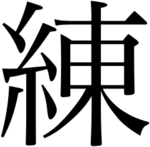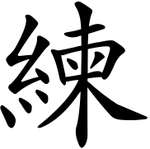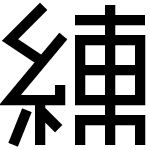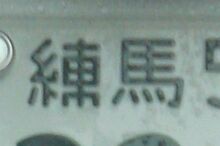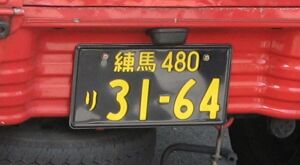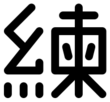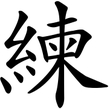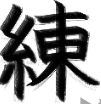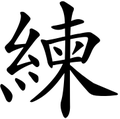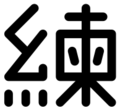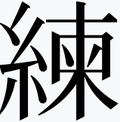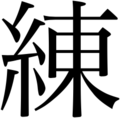Difference between revisions of "練"
(Created page with "<div style="float:right;margin:-70px -14px 0px 6px; background-color:#ffFFff"> 150px 150px <center...") |
|||
| (2 intermediate revisions by the same user not shown) | |||
| Line 158: | Line 158: | ||
==Graphic== |
==Graphic== |
||
| + | <div style="float:right;margin:-20px 0px 0px 0px; background-color:#ffFFff"> |
||
| + | [[File:X7DF4LM.png|110px]] [[File:U7DF4L.png|110px]] |
||
| + | <center> |
||
| + | Two more interpretations of [[X7DF4]] [[練]] |
||
| + | </center> |
||
| + | </div> |
||
[[練]] looks as combination of two columns: |
[[練]] looks as combination of two columns: |
||
| Line 446: | Line 452: | ||
None of these dictionaries mention the most often use of character [[X7DF4]] [[練]], namely, in word [[Nerima]] (for example, [[練馬]]). |
None of these dictionaries mention the most often use of character [[X7DF4]] [[練]], namely, in word [[Nerima]] (for example, [[練馬]]). |
||
| + | |||
| + | ==Gallery== |
||
| + | |||
| + | [[File:U7DF4L.png|120px]] |
||
| + | [[File:X7DF4LM.png|120px]] |
||
| + | [[File:XdF4wL.png|120px]] |
||
| + | [[File:U7DF4m.png|120px]] |
||
| + | [[File:X7DF4j.png|120px]] |
||
| + | [[File:Neri06.png|120px]] |
||
==References== |
==References== |
||
Latest revision as of 13:59, 8 August 2021
練 by Unicode Utilities [1] at Mac and at Linux
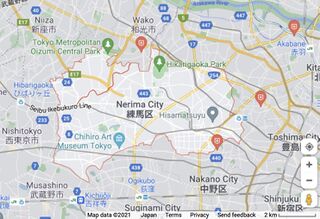
Nerima by Google at map
練 (練, X7DF4) is Unicode character number 32244, KanjiLiberal.
Character X7DF4 練 can be pronounced as "neru" or "neri".
It may refer to practice, treatment.
Character X7DF4 練 is easy to confuse with other Unicode characters.
Neri, Uma and Nerima
Character 練 (or other Neri) often appears in combination with one of characters uma:
X2FBA ⾺ [2], KanjiRadical or
X99AC 馬 [3], KanjiLiberal
Example: 練馬
Such a combination refers to Nerima, prefecture near Tokyo.
At the vehicle license plates, character 練 appears with the specific font (see figure below), that may have no analogies in computers. It looks similar to characters Neri. Character X7DF4 練 seems to be more usual, than other Neri. For this reasons, the first kanji at the license plates shown in figures below, is treated as unicode character 練 X7DF4.
Encoding
Character X7DF4 練 is easy to confuse with other Kanjis.
The Unicode Utilities report the confusion for the following characters:
X7DF4 練 [1], KanjiLiberal
XF996 練 [4], KanjiConfudal
XFA57 練 [5], KanjiConfudal
XFAB0 練 [6], out of tables of Kanjis loaded in TORI.
At some computers, these characters look similar.
Even a native Japanese speaker, seeng characters
練,
練,
練,
is unlikely to answer:
Which of them is X7DF4?
Which of them is XF996?
Which of them is XFA57?
The software also may confuse these characters, replacing 練 and 練 to 練 (giving to a Human no chance to identify such a character).
In order to avoid the confusion, distinguish these characters, some programming is necessary. The Utf8 encoding of these characters can be calculated using the PHP program ud.t by command
php ud.t 7DF4 F996 FA57 FAB0
The output is:
7DF4 32244 練 練
Unicode character number 32244 id est, X7DF4
Picture: 練 ; uses 3 bytes. These bytes are:
XE7 XB7 XB4 in the hexadecimal representation and
231 183 180 in the decimal representation
F996 63894 練 練
Unicode character number 63894 id est, XF996
Picture: 練 ; uses 3 bytes. These bytes are:
XEF XA6 X96 in the hexadecimal representation and
239 166 150 in the decimal representation
FA57 64087 練 練
Unicode character number 64087 id est, XFA57
Picture: 練 ; uses 3 bytes. These bytes are:
XEF XA9 X97 in the hexadecimal representation and
239 169 151 in the decimal representation
FAB0 64176 練 練
Unicode character number 64176 id est, XFAB0
Picture: 練 ; uses 3 bytes. These bytes are:
XEF XAA XB0 in the hexadecimal representation and
239 170 176 in the decimal representation
Teachers of Japanese, as well as the textbooks of Japanese, do not even mention the problem of the encoding. They leave the students to learn to handle the errors, bugs, mistakes and other problems, related with the encoding, by themselves.
The same refers to dictionaries and to software, that supports the Unicode characters:
the authors of not even mention that some characters look very similar, letting the users to guess by themselves: why the "same" character is interpreted in different ways?
The revealing of the characters that make confusion (looking similar to each other) may reduce amount of patients of psychiatric clinics, who loss their minds in believe, that they forgot to write something, while the different encoding of the "same" character happens.
Graphic
練 looks as combination of two columns:
Left:
1. ascii character "<" o rmirrored ascii character "y"
2. JapanMu, any of characters
X2F1B ⼛ [7], KanjiRadical
X30E0 ム [8], Katakana, KatakanaMu
X53B6 厶 [9], KanjiLiberal
3. JapanSmall, any of characters X2F29 ⼩ or X5C0F 小
Right:
View of character X7DF4 strongly depend on the software; looking at its presentation at Macintosh and at Linux, it is difficult to guess, that they show the same Kanji.
Equally difficult is to guess, that the first kanji, that appears at the vehicle license plate of Nerima prefecture is just slightly modified character
X7DF4 練 [1], KanjiLiberal or
XF996 練 [4], KanjiConfudal or
XFA57 練 [5], KanjiConfudal
that can be considered as synonyms: they have similar drawing, similar pronunciation and similar meaning.
Jisho
14 strokes
Radical: silk 糸 (糹)
Parts: | ハ 小 幺 日 木 田 糸
practice, gloss, train, drill, polish, refine
Kun: ね.る、 ね.り
On: レン
Jōyō kanji, taught in grade 3
JLPT level N2
788 of 2500 most used kanji in newspapers
On reading compounds
練習 【レンシュウ】 practice, training, drill, (an) exercise, workout
練達 【レンタツ】 expert(ise), skill, dexterity
修練 【シュウレン】 training, drill, practice, practising, discipline
水練 【スイレン】 swimming practice
Kun reading compounds
練る 【ねる】 to knead, to thicken into a paste (stirring over a flame), to polish (a plan, etc.), to refine, to elaborate, to work out, to train, to drill, to exercise, to gloss (silk), to soften, to degum, to tan (leather), to temper (steel), to walk in procession, to parade, to march
練り 【ねり】 kneading, gloss, tempering, paste (e.g. bean paste, mustard paste), parading of portable shrines and floats at festivals
練り上げる 【ねりあげる】 to knead well, to polish, to refine
Nihongomaster
Nihongomaster [12] suggests:
練 14 Strokes Radicals: | 糸 幺 小 日 ハ 木 JLPT Level 2
Definition of 練 practice gloss train drill polish refine
Readings
On'Yomi (音読み)
レン
Kun'yomi (訓読み)
ねる
ねり
Popular Words With This Kanji
練習, れんしゅう practice, practise
訓練, 訓連, くんれん practice, practise, training
練る, 煉る, ねる to knead, to thicken into a paste (stirring over a flame), to polish (a plan, etc.), to refine, to elaborate, to work out, to train, to drill, to exercise, to gloss (silk), to soften, to degum, to tan (leather), to temper (steel), to walk in procession, to parade, to march
試練, 試煉, 試錬, しれん test, trial, probation, ordeal, tribulation
洗練, 洗煉, 洗錬, せんれん polish, refinement
熟練, じゅくれん skill, dexterity, proficiency
未練, みれん lingering affection, attachment, regret, regrets, reluctance
練り直す, 練りなおす, 練直す, ねりなおす to knead again, to rework, to revise, to polish
Confusion
Character X7DF4 練 is qualified as Neri.
It looks similar to other Neri characters, this may cause confusion. This confusion is recognized in the literature [1] [4] [5] [6].
Character X7DF4 練 seems to be more usual than other Neri characters, as it is presented both in Jisho [11] and in Nihongomaster [12].
None of these dictionaries mention the most often use of character X7DF4 練, namely, in word Nerima (for example, 練馬).
Gallery
References
- ↑ Jump up to: 1.0 1.1 1.2 1.3 https://util.unicode.org/UnicodeJsps/character.jsp?a=7DF4 練 7DF4 CJK UNIFIED IDEOGRAPH-7DF4 Han Script id: restricted confuse: 練 , 練 , 練 ..
- ↑ https://util.unicode.org/UnicodeJsps/character.jsp?a=2FBA ⾺ 2FBA KANGXI RADICAL HORSE Han Script id: allowed confuse: 馬
- ↑ https://util.unicode.org/UnicodeJsps/character.jsp?a=99AC 馬 99AC CJK UNIFIED IDEOGRAPH-99AC Han Script id: restricted confuse: ⾺ ..
- ↑ Jump up to: 4.0 4.1 4.2 https://util.unicode.org/UnicodeJsps/character.jsp?a=F996 練 F996 CJK COMPATIBILITY IDEOGRAPH-F996 Han Script id: allowed confuse: 練 , 練 , 練 ..
- ↑ Jump up to: 5.0 5.1 5.2 https://util.unicode.org/UnicodeJsps/character.jsp?a=FA57 練 FA57 CJK COMPATIBILITY IDEOGRAPH-FA57 Han Script id: allowed confuse: 練 , 練 , 練 ..
- ↑ Jump up to: 6.0 6.1 https://util.unicode.org/UnicodeJsps/character.jsp?a=FAB0 練 FAB0 CJK COMPATIBILITY IDEOGRAPH-FAB0 Han Script id: allowed confuse: 練 , 練 , 練 ..
- ↑ https://util.unicode.org/UnicodeJsps/character.jsp?a=2F1B ⼛ 2F1B KANGXI RADICAL PRIVATE Han Script id: allowed confuse: 厶
- ↑ https://util.unicode.org/UnicodeJsps/character.jsp?a=30E0 ム 30E0 KATAKANA LETTER MU Katakana Script id: restricted confuse: none
- ↑ https://util.unicode.org/UnicodeJsps/character.jsp?a=53B6 厶 53B6 CJK UNIFIED IDEOGRAPH-53B6 Han Script id: restricted confuse: ⼛
- ↑ https://util.unicode.org/UnicodeJsps/character.jsp?a=6771 東 6771 CJK UNIFIED IDEOGRAPH-6771 Han Script id: restricted confuse: none ..
- ↑ Jump up to: 11.0 11.1 11.2 https://jisho.org/search/%23kanji%20練 練 14 strokes Radical: silk 糸 (糹) Parts: | ハ 小 幺 日 木 田 糸 practice, gloss, train, drill, polish, refine Kun: ね.る、 ね.り On: レン Jōyō kanji, taught in grade 3 JLPT level N2 788 of 2500 most used kanji in newspapers Words starting with 練 Words ending with 練 Words containing 練 External links Stroke order On reading compounds 練習 【レンシュウ】 practice, training, drill, (an) exercise, workout 練達 【レンタツ】 expert(ise), skill, dexterity 修練 【シュウレン】 training, drill, practice, practising, discipline 水練 【スイレン】 swimming practice Kun reading compounds 練る 【ねる】 to knead, to thicken into a paste (stirring over a flame), to polish (a plan, etc.), to refine, to elaborate, to work out, to train, to drill, to exercise, to gloss (silk), to soften, to degum, to tan (leather), to temper (steel), to walk in procession, to parade, to march 練り 【ねり】 kneading, gloss, tempering, paste (e.g. bean paste, mustard paste), parading of portable shrines and floats at festivals 練り上げる 【ねりあげる】 to knead well, to polish, to refine
- ↑ Jump up to: 12.0 12.1 https://nihongomaster.com/dictionary/kanji/2913/練 練 14 Strokes Radicals: | 糸 幺 小 日 ハ 木 JLPT Level 2 Definition of 練 practice gloss train drill polish refine Readings On'Yomi (音読み) Kun'yomi (訓読み) レン ねる ねり Popular Words With This Kanji 練習, れんしゅう practice, practise 訓練, 訓連, くんれん practice, practise, training 練る, 煉る, ねる to knead, to thicken into a paste (stirring over a flame), to polish (a plan, etc.), to refine, to elaborate, to work out, to train, to drill, to exercise, to gloss (silk), to soften, to degum, to tan (leather), to temper (steel), to walk in procession, to parade, to march 試練, 試煉, 試錬, しれん test, trial, probation, ordeal, tribulation 洗練, 洗煉, 洗錬, せんれん polish, refinement 熟練, じゅくれん skill, dexterity, proficiency 未練, みれん lingering affection, attachment, regret, regrets, reluctance 練り直す, 練りなおす, 練直す, ねりなおす to knead again, to rework, to revise, to polish 練り直す, 練りなおす, 練直す, ねりなおす to knead again, to rework, to revise, to polish 練り直す, 練りなおす, 練直す, ねりなおす to knead again, to rework, to revise, to polish
Keywords
Japanese, Kanji, KanjiConfudal, KanjiLiberal, KanjiRadical, Neri, Nerima, Uma, Unicode, X7DF4 練 , XF996 練 , XFA57 練 ,
